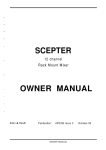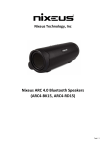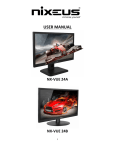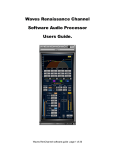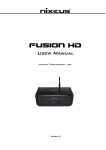Download scepter service manual
Transcript
ALLEN&HEATH WARNING – HIGH VOLTAGES Power Supply Unit (PSU) work should only be carried out by qualified personnel. We recommend that you use an approved Allen & Heath service centre for all power supply work. Please contact your local Allen & Heath distributor for more details. http://www.allen-heath.com/ Section 5 Audio Owner Manual SERVICE ACCESS ACCESS TO MIXER CIRCUITS To implement any User Options, you will need to gain access to the internal circuit cards, The various jumper links later defined are located on those cards. Follow the outlined procedure to safely open the Scepter mixer. The Scepter is composed of individual glass-epoxy circuit cards secured to a silk-screened aluminum front panel. A steel rear panel is secured to the rear of the circuit cards by numerous jack nuts. This sub-assembly (i.e. Front panel, Circuit cards and Rear Panel) is then inserted into a steel chassis. Eight 6x32 front panel counter-sunk screws and eight 6x32 rear panel screws hold both assemblies together. The front carrying handles also hold the two assemblies together with four 10x32 screws. In order to get to the jumper links, you will have to first remove the Front panel/Circuit card/Rear panel sub-assembly from the chassis and then remove the Rear panel from the Circuit cards. The jumper links will then be accessible. NOTE: If you need to change only the Master options (Mono or Stereo Out Jumpers) then the Rear panel DOES NOT have to be separated from the Circuit cards. Eliminate step 2 and proceed as far as step 7. DISASSEMBLY Perform all work on a soft surface to prevent undue scratching of the Scepter unit. Place the Scepter face down (resting on its handles) on a soft surface Loosen (do not remove yet) the black plastic nuts from the l/4” jacks. Remove the 8 panel screws securing the Rear panel to the chassis. Turn the Scepter over and remove the 8 countersunk screws securing the Front panel to the Chassis. At this point the Handles screws are the only fasteners holding the Front panel Assembly to the Chassis. Support the Scepter on its front, but without using the handles for support. Use a foam block or similar item 2” or greater in height to clear the handles. Remove the 4 countersunk handle screws. Hold onto the handles when performing this step to prevent them from rotating and possibly scratching the Front panel. Lift the Chassis off the Front panel assembly. At this point you may make changes to the Master jumper links. The remaining steps should only be performed if you need to remove the Rear panel. (This is necessary if Input or L/R jumper links have to be changed or if servicing needs 30 Section 5 Audio Owner Manual - a - -- 9 10 11 to be carried out. Free the DC power XLR-5 pin insert from its metal shell by using a small screwdriver to loosen the XLR setscrew (anti-clockwise). The insert can then be pulled out the back of the XLR shell. The DC wires to the Master card will remain attached to the insert. Remove the loosened plastic nuts from the l/4” jacks. Remove the 2 fixing screws from each XLR jack. Lift the Rear panel off the circuit cards. The Circuit cards are now accessible for changes to the jumper links or repair work. If the main IDC 20 way ribbon harness is removed for service, use care when it is replaced. Make sure that all pins on all Circuit cards are correctly inserted into the IDC sockets; it is easy to bend a pin or mistakenly shift over one pin when putting a socket on. When re-assembling the Scepter, follow the above steps in reverse order. The diagram below shows a header and Jumper link arrangement. REMOVABLE JUMPER DUAL ROW HEADER - 31 Section 5 Audio Owner Manual USER CONFIGURED OPTIONS There are a number of User options available on the Scepter mixer. They are implemented with removable jumper links that the user can move to different combinations of header pins; no soldering is necessary. (except for the left and right Stereo Return options). To alter any of the User Configured Options you will have to gain access to the internal circuit cards. Please read the ACCESS TO MIXER CIRCUITS procedure in the SERVICE ACCESS section. OPTION DESCRIPTIONS Input Channel Options Seven different options are available on each Input channel: Direct Out Aux send source select Pre-EQ source select Pre-EQ mute select 1 of 3 choices 1 of 3 choices for each Aux 1 of 3 choices 1 of 2 choices Direct Out Three choices are available for the Channel Direct Out. Normally the Direct Out is set to follow the Fader and Mute switch, however there may be situations when you may want the Direct Out to stay active even if the Channel is muted. This would allow you to use each input as an independent preamp. If the channel is muted, the signal would appear only at the Direct Out jack; the Aux sends and L/R pan feed would be cut. 1 Post-Fader/Post-Mute The Direct Out follows the Channel fader and Mute switch. This option is factory set. 2 Post-Fader/Pre-Mute The Direct Out follows the Channel fader but the Mute switch has no effect on the signal. 3 Pre-Fader/Pre-Mute Neither the fader nor Mute switch affect the Direct out. 32 Section 5 Audio Owner Manual - - -.- Channel Aux Send Source Select Three choices are available for each of the four Auxiliary Sends. Aux A & B are set up as Monitor or Cue sends (Pre-EQ/Pre-Fader); Aux C & D are set as EFX sends (Post-Fader). Normally all Aux sends are muted along with the channel, but the Pre-EQ source can be set to ignore the Mute switch. (see Pre-Eq Mute/No mute section) The Pre-EQ can also be set to 1 of 3 different configurations (See Pre-EQ Source Select). 1 Pre-EQ Aux Send signal follows Gain control only. Auxes A & B default factory setting. This source has 3 extra configuration options. (see Pre-Eq Source Select) 2 Pre-Fader Aux Send follows the EQ and Mute switches; Fader level has no effect. Same signal as PFL. 3 Post-Fader Aux Send follows Fader and Mute Switch. Used for Effect send. Auxes C & D default factory setting. Pre-EQ Source Select Three choices are provided for the Pre-EQ source. Normally the Post-Insert/ Post-HPF option is selected. The aux signal will be after any signal processing equipment you may have patched into the Channel Insert jack and also the channel High pass filtering. If you want the Aux send to be unaffected by the external equipment, select the Pre-Insert option. Likewise, choose the Post-lnsert/Pre-HPF point if you want the Aux to have the effect but not have the High Pass Filtering. - 1 Pre-Insert Pre-EQ point is directly after the channel preamp section. Any external equipment will not affect the aux send signal. 2 Post Insert/Pre-HPF Pre-EQ point follows any external equipment but is not affected by HPF switch. 3 Post Insert/Post HPF Pre-EQ signal is after any external processing equipment and is affected by the HPF switch. This is the factory default setting. 33 Section 5 Audio Owner Manual PreEQ Mute/No Mute The Pre-EQ source (1 of 3 selected above) can be set to follow the Channel Mute switch or to ignore it. It is normally set to follow the mute. If you desire the source to be active even when the channel is muted, configure the No Mute option. 1 Pre-EQ Mute Pre-EQ source will mute with the Channel. This is the factory default setting. 2 Pre-EQ No Mute Pre-EQ source will remain on even when the channel is muted. Left and Right Stereo Return Options There are four 10k Ohm resistors (brown,black,orange) that can be set on each L/R card. These four resistors are located behind the two Aux controls. They select the source for the two Aux sends on each Stereo return. You have many variations, for each of the two Aux send sources. If you select both a Left and Right source, the Aux will be a mono mix of the Stereo return. 1 L-R return Pre-level Aux sends A & B configured to follow the pre-level mono mix of left and right return. This is the factory default setting. 2 L-R return Post level Aux sends A & B configured to follow after the post level mono mix of left and right return. If you want to change to Aux A Left only and Aux B Right only, remove the appropriate resistors. You may then configure the resistors for pre or post level for each aux send. 3 Left return Pre-level Aux sends A and/or B can be configured to follow the left return only. 4 Left return Post-Level Aux sends A and/or B can be configured to follow just the left return after the level control and mute switch. 5 Right return Pre-level Aux sends A and/or B can be configured to follow the right return only. 6 Right return Post-level Aux sends A and/or B can be configured to follow just the right return after the level control and mute switch. 34 Audio Owner Manual Section 5 Master Options The user can choose the sources for both the Balanced MONO out XLR connector and the STEREO OUT l/4” jack socket. These outputs are derived from some point in the main Left and Right audio path. The options are: Pre-Insert, PostInsert/Pre-Fader and Post-Fader. Normally both the Mono and Stereo outputs are set for Pre-Insert. This makes them independent of the main L & R faders and any processing equipment that is patched into the Left or Right Insert jacks. 1 Mono Out Pre-Insert Output is a mono mix of the main left & right pre-insert signal. This is the factory default setting. 2 Stereo Out Pre-Insert Output is the main left & right pre-insert signal. Tip is left and Ring is right. This is the factory default setting. Configure the jumper links for Post Insert if you want the MONO and STEREO OUT signals to be affected by any external processing equipment patched into the L & R Inserts. 3 Mono Out Post Insert Output is a mono mix of the main left & right post insert signal. The L & R fader levels have no effect. 4 Stereo Out Post Insert Output is the main left & right post insert signal. Tip is left and Ring is right. The L & R fader levels have no effect. Configure the jumper links for Post-Fader to have both outputs follow the main L & R outputs. 5 Mono Out Post Fader Output is a mono mix of the main left & right post fader signal. Equivalent to a mono mix direct out. 6 Stereo Out Post Fader Output is the main left & right post fader signal. Tip is left and Ring is right. Equivalent to a stereo direct out. The Mono Output header mixes the two selected sources together. The Stereo Out header routes the left source to the left out and the right source to the right out. Two extra positions are available on the Stereo out header. These points are Section 5 Audio Owner Manual brought out to holes in the circuit board allowing you to feed an Aux output or other signal to the Stereo Out. Solder a wire between the hole pad and the desired signal point and move the header to the Ext position. OPTIONS TABLE All the possible Scepter user options are listed in the table below with the factory defaults indicated with an X. Diagrams on the following pages show the Scepter circuit cards and where the various jumper links and default jumpers are located. L/R GROUP INPUT CHANNEL Stereo Return Aux Feeds Iirect Out 4ux A Source Post-Fader Pre-Fader Pre-EQ X 4ux B Source Post-Fader Pre- Fader Pre-EQ X 4ux C Source Post-Fader X Pre-Fader Pre-EQ 4ux D Source Post-Fader X Pre- Fader Pre-EQ Pre-EQ Source Pre-EQ Mute I Post-Fader/Post-Mute X Post-Fdr/Pre-Mute Pre- Fader Post-Insert/Post-HPF X Post-Insert/Pre-HPF Pre-insert 4ux A Source (Mixes L & R) Left Rtn: Left Rtn: Right Rtn: Right Rtn: Post-Level Pre-Level X Post-Level Pre-Level X 4ux B Source (Nixes L & R) Left Rtn: Post-Level Left Rtn: Pre-Level X Right Rtn: Post- Level Right Rtn: Pre-Level X MASTER Ion0 Out Mixes L & R) Left: Pre-Insert X Left: Post Insert Left: Post-Fader Right: Pre-Insert X Right: Post Insert Right: Post- Fader stereo Out Left Left: Pre-Insert X Left: Post Insert Left: Post-Fader Ext PC Pad Stereo Out Right Right: Pre-Insert X Right: Post Insert Right: Post- Fader Ext PC Pad Mute With Channel X No Mute With Channel 36 Section 5 Audio Owner Manual - CHASSIS GROUND LIFT - - Normally the chassis of the Scepter is connected to the audio ground with a link on the DC Input connector. The chassis can be lifted from the audio ground by removing this link. This should not be confused with disconnecting the ground on an AC plug. The AC ground is a safety ground; it is there as protection from electrocution if some component should fail and cause an exposed surface to become live. The safety ground is designed to shunt this voltage to ground, causing the equipment or outlet fuse to blow. The Power supply chassis is attached to this AC ground since there are potentially hazardous voltages inside the case. The Scepter chassis and audio ground are isolated from this AC ground since the Power Supply feeds only low-voltage DC to the mixer. The Scepter chassis and audio ground are floating in respect to the AC ground; they will obtain their ground from the external equipment they are attached to. In most rack situations, there are a number of grounds tied together via the metal rack rails. This can lead to ground loops which may cause hum in a system. These ground loops can be eliminated in many casesby isolating the equipment audio ground from this metal rail. If you need to isolate the Scepter chassis then follow the procedure outlined below: The Scepter is also provided with Pin-l lifts on all its Balanced outputs. In some cases lifting Pin 1 is all that is required to fix a ground loop problem. 1 2 3 4 5 Chassis-Audio Ground isolation procedure: Release the DC Power connector from the rear panel by removing the 2 fixing screws Carefully ease the connector out and locate the chassis lug (see diagram) Locate the bare wire link that is attached to this lug(see diagram) Cut this wire and dress it to prevent shorting. Re-install the connector and screws. REAR PANEL REMOVE THESE 2 SCREWS TO FREE DC POWER JACK FROM REAR PANEL DC POWER WIRES UT THIS BARE WlRf FROM THE SOLDER LUG TO ISOLATE THf CHASSIS FROM THE AUDIO GROUND DC POWER INPUT 5-PIN XLR - 37 Audio Owner Manual - - - Section 6 SERVICE INFORMATION AND DIAGRAMS h/iAIN RIBBON SIGNALS TOP VIEW 19 1 20 2 u u u u u u u u u u VIEW ON PINS h,IAIN RIBBON SIGNALS J 17 AUDIO +15 VOLTS 19 AUDIO -15 VOLTS 18 LED +15 VOLTS 20 LED -15 VOLTS NOTE: The Silkscreen legends on the PCBs are in error (odds and evens are reversed). locations are correct as sho&m above. Pin ID SCEPTER R A CK MIXER - 10 RACK SPACES DEPTH BEHIND PANEL 1 19 (483) PANEL (94) HEIGHT ABOVE 1 .4 (36) PANEL (HANDLES) 1 .o (25) CHASSIS ! / \ RACK EAR WIDTH I I f------------- 1 7 ( 4 3 2 ) ------_-_--------------MPS-8R POWER SUPPLY - 2 RACK SPACES 1 19 (483) - ‘1 (280) - ALL DIMENSIONS IN INCHES & (MM)





















